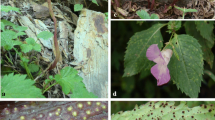Abstract
The objective of this study was to find features in microcyclic rust fungi (Uredinales) on wild host plants favorable for extension of the natural range of distribution. Puccinia glechomatis, a leptosporic rust fungus and its herbal host Glechoma hederacea (Lamiaceae), both natives to Eurasia and introduced in North America, were used for this study. Although the host has been known from North America since the beginning of the nineteenth century, the rust fungus was first observed there only in recent years. Favorable features were identified by studying the life cycle of the rust, including nuclear conditions and seasonal characteristics as well as its spread in North America. The life cycle was studied macroscopically by inoculation experiments, by various light microscope techniques, and by scanning electron microscopy. The spread of the pathogen and its host were reconstructed by evaluating host plant herbarium specimens and databases, literature, and field study data. The studies on P. glechomatis show that, generally for microcyclic rust fungi, establishment and potential for spread are based on several favorable features of both the host (e.g., synanthropic occurence and dispersal, genetic stability, regeneration of vegetative plant parts) and the rust fungus (asexual reproduction/genetic stability, homothallism, propagation with host plant, formation of both leptospores and thick-walled teliospores).
Similar content being viewed by others
References
RF Allen (1933) ArticleTitleA cytological study of the teliospores, promycelia and sporidia in Puccinia malvacearum Phytopathology 23 572–586
D Ashworth (1931) ArticleTitle Puccinia malvacearum in monosporidial culture Trans Br Mycol Soc 16 177–202 Occurrence Handle10.1016/S0007-1536(31)80031-2
J BÖllmann M Scholler (2004) ArticleTitle Glechoma hederacea (Lamiaceae) in North America: invasion history and current distribution Fed Rep 115 178–188 Occurrence Handle10.1002/fedr.200311035
R Cousens M Mortimer (1995) Dynamics of weed populations Cambridge University Press Cambridge
JF Crow (1986) Basic concepts in population, quantitative, and evolutionary genetics Freeman New York
PE Crane Y Hiratsuka RS Currah (2000a) ArticleTitleClarification of the life-cycle of Chrysomyxa woroninii on Ledum and Picea Mycol Res 104 581–586 Occurrence Handle10.1017/S0953756299001677
PE Crane Y Hiratsuka RS Currah (2000b) ArticleTitleReproductive biology and evidence for water dispersal of teliospores in Chrysomyxa weirii, a microcyclic spruce needle rust Mycologia 92 754–763
H Ellenberg HE Weber R DÜll V Wirth W Werner D Paulissen (1992) ArticleTitleZeigerwerte von Pflanzen in Mitteleuropa Scr Geobot 18 1–166
J Eriksson (1911) ArticleTitleDer Malvenrost (Puccinia malvacearum Mont.), seine Verbreitung, Natur und Entwicklungsgeschichte Kgl Svenska Vet Akad Handl 47 1–125
DE Gardner (1981) ArticleTitleNuclear behaviour and clarification of the spore stages of Uromyces koae Can J Bot 59 939–946
DE Gardner (1996) ArticleTitle Puccinia rugispora: an unusual microcyclic rust endemic to Hawaii Mycologia 88 671–676
E GÄumann (1951) Pflanzliche Infektionslehre Birkhäuser Basel
PH Gregory (1973) The microbiology of the atmosphere EditionNumber2nd edn Leonard Hill Aylesbury, UK
JR Hernández M Daughtrey J Jens (2003) ArticleTitleOccurrence of the rust disease caused by Puccinia lagenophorae on Cineraria in the Americas Plant Dis 87 1266
N Hiratsuka T Sato K Katsuya M Kakishima Y Hiratsuka S Kaneko Y Ono S Sato Y Harada T Hiratsuka K Nakayama (1992) The rust flora of Japan Tsukuba Shuppankai Ibaraki
MJ Hutchings EAC Price (1999) ArticleTitle Glechoma hederacea L. (Nepeta glechoma Benth., N. hederacea (L.) Trev J Ecol 87 347–364 Occurrence Handle10.1046/j.1365-2745.1999.00358.x
S Koike M Scholler (2001) ArticleTitleFirst occurrence of a rust fungus on English daisy (Bellis perennis) Plant Dis 85 562
H Kreisel M Scholler (1994) ArticleTitleChronology of phytoparasitic fungi introduced to Germany and adjacent countries Bot Acta 107 387–392
LJ Littlefield SM Marek RJ Tyrl KS Winkelmann (2005) ArticleTitleMorphological and molecular characterization of Puccinia lagenophorae, now present in central North America Ann Appl Biol 147 35–42
H MÜller-Schärer GS Wyss (1994) ArticleTitleDas Gemeine Kreuzkraut (Senecio vulgaris L.): Problemunkraut und Möglichkeiten der biologischen Bekämpfung Z Pfl Krankh Pfl Schutz Sonderh 14 201–209
K Narisawa Y Yamaoka K Katsuya (1993) ArticleTitleEstablishment of axenic culture of Puccinia coronata var. coronata from basidiospores and their nuclear conditions Trans Mycol Soc Jpn 34 37–45
Y Ono (2002) ArticleTitleLife cycle and nuclear behavior in three rust fungi (Uredinales) Mycoscience 43 37–45 Occurrence Handle10.1007/s102670200007
ME Palm AY Rossmann (2003) Invasion pathways of terrestrial plant-inhabiting fungi GM Ruiz JT Carlton (Eds) Invasive species: vectors and management strategies Island Press Washington, DC 31–43
DBO Savile (1976) ArticleTitleEvolution of the rust fungi (Uredinales) as reflected by their ecological problems Evol Biol 9 137–207
DBO Savile (1978) ArticleTitlePaleoecology and convergent evolution in rust fungi (Uredinales) BioSystems 10 31–36 Occurrence Handle10.1016/0303-2647(78)90026-6
M Scholler (1996) ArticleTitleDie Erysiphales, Pucciniales und Ustilaginales der Vorpommerschen Boddenlandschaft. Ökologisch-floristische, florengeschichtliche und morphologisch-taxonomische Untersuchungen Regensb Mycol Schr 6 1–325
M Scholler (1999) ArticleTitleObligate phytoparasitic neomycetes in Germany: diversity, distribution, introduction patterns, and consequences Texte Umweltbundesamt 18 64–75
M Scholler (2000) ArticleTitleRust on ground-ivy found for the first time in North America Plant Dis 84 371
M Scholler S Koike (2001) ArticleTitleFirst occurrence of Puccinia lagenophorae causing rust disease on groundsel in North America Plant Dis 85 335
P Sydow H Sydow (1904) Monographia Uredinearum, vol 1: genus Puccinia Borntraeger Leipzig
RH Uva JC Neal JM DiTomaso (1997) Weeds of the Northeast Cornell University Press New York
J-Y Zhuang (2003) Flora Fungorum Sinicorum, vol 19. Uredinales (II) Science Press Beijing
Author information
Authors and Affiliations
Corresponding author
About this article
Cite this article
Böllmann, J., Scholler, M. Life cycle and life strategy features of Puccinia glechomatis (Uredinales) favorable for extending the natural range of distribution. Mycoscience 47, 152–158 (2006). https://doi.org/10.1007/s10267-006-0282-z
Received:
Accepted:
Issue Date:
DOI: https://doi.org/10.1007/s10267-006-0282-z




